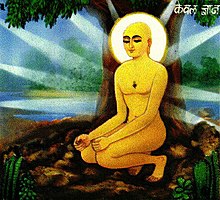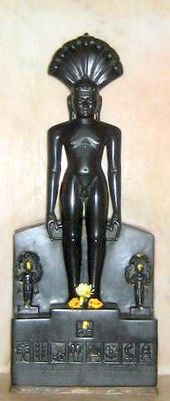Jainism

Kevala Jñāna of Mahavira in "mulabandhasana" posture
Dr. Heinrich Zimmer contended that the yoga system had pre-Aryan origins that did not accept the authority of the Vedas, and hence had to be reckoned as one of the heterodox doctrines similar to Jainism.[77] Jain iconography depicts Jain Tirthankara's meditation in "Padmasana" or "Kayotsarga" yogic poses. Mahavira was said to have achieved "Kevala Jnana" "enlightenment" siting in "mulabandhasana" ('root-lock') position, which is first mentioned in the Acaranga Sutra and later in Kalpasutra [78]
The five yamas or the constraints of the Yoga Sutras of Patanjali bear an uncanny resemblance to the five major vows of Jainism, indicating a strong influence of Jainism.[79][80] This mutual influence between the Yoga philosophy and Jainism is admitted by the author Vivian Worthington who writes: "Yoga fully acknowledges its debt to Jainism, and Jainism reciprocates by making the practice of yoga part and parcel of life." [81] The Indus valley seals and iconography also provide a reasonable evidence of the existence of a proto-yogic tradition akin to Jainism.[82]
More specifically, scholars and archaeologists have remarked on close similarities in the yogic and meditative postures depicted in the seals with those of various Tirthankaras: the "kayotsarga" posture of Rsabha and the "mulabandhasana" of Mahavira along with seals depicting meditative figure flanked by upright serpents bearing similarities to iconography of Parsva. All these are indicative of not only links between Indus Valley Civilisation and Jainism, but also show the contribution of Jainism to various yogic practices.[83]
] References in Jain canons and literature
Earliest of Jain canonical literature like Acarangasutra and texts like Niyamasara, Tattvarthasutra etc. had many references on yoga as a way of life for laymen and ascetics. The later texts that further elaborated on the Jain concept of yoga are as follows:- Pujyapada (5th century CE)
- Ishtopadesh
- Acarya Haribhadra Suri(8th century CE)
- Yogabindu
- Yogadristisamuccaya
- Yogasataka
- Yogavimisika
- Acarya Joindu (8th century CE)
- Yogasara
- Acarya Hemacandra (11th century CE)
- Yogasastra
- Acarya Amitagati (11th century CE)
- Yogasaraprabhrta

No comments:
Post a Comment